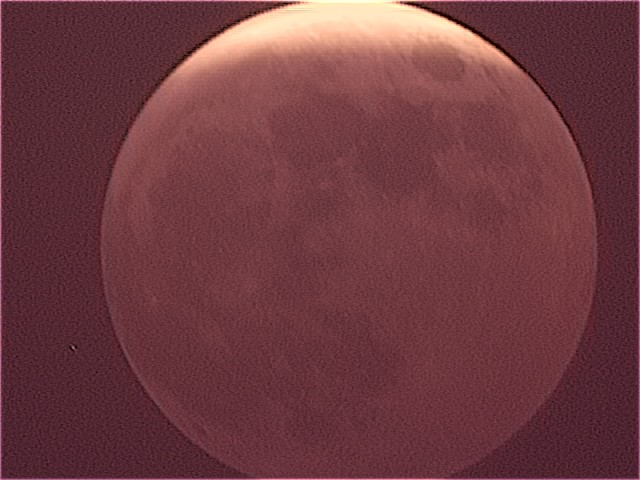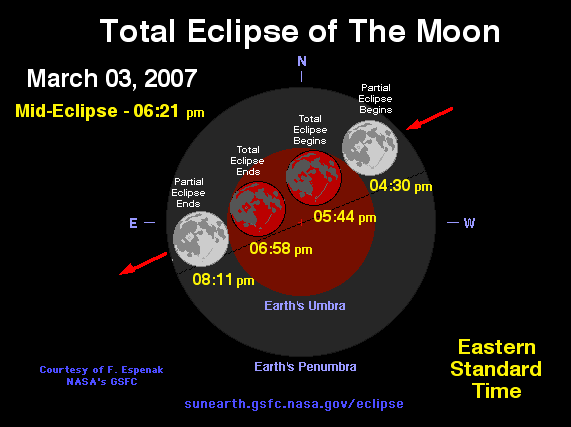 |
03/03/2007 ~23:10 T.U. |
Immagine di Daniele DA RIO |
Ripresa dall'Osservatorio Astronomico di Talmassons (Ud) |
Sezione Luna |
 | ||||
| ECLISSI TOTALE DEL 3-4 MARZO 2007 | ||||
| LA FASE DI TOTALITA' | ||||
Nella notte del plenilunio fra il 3 e il 4 marzo 2007, si è verificata un'eclissi totale di Luna, col nostro satellite naturale posto nelle migliori condizioni per la ripresa, visto che era altissimo in cielo e la totalità avveniva a metà della notte. Il fenomeno è stato altamente spettacolare e le 500-600 persone giunte in osservatorio, con una stima che vi fornisco ad occhio, si sono divertite per varie ore. Rispetto alle tre eclissi totali precedenti, stavolta il cielo era sereno, senza nuvole da un orizzonte all'altro sino quasi alla sua conclusione, quando sono sopraggiunti dei cirri che ne hanno comunque permesso la visione. A parte l'eclissi parziale del 7 settembre 2006, quella di penombra del 14 marzo 2006 e quella totale (ma con la luna che tramontava a metà totalità) del 16 maggio 2003, per noi friulani era dal 9 gennaio 2001 che non ne vedevamo una completa! E' comprensibile che la "voglia" dei soci del CAST fosse tanta e che si sia cercato di soddisfare le richieste di osservazione da parte del pubblico giunto da ogni parte della regione nel miglior modo possibile, anche a costo di sacrificare quasi tutte le riprese fotografiche. L'immagine presentata qui sopra è stata scattata dal socio Daniele Da Rio di Gemona del Friuli (Ud), il quale ci presenta un'immagine "grezza" prelevata dalla webcam così com'è venuta e ancora senza elaborazione, giusto per mostrarvi il disco selenico completamente eclissato dall'ombra della Terra: è il fenomeno della "Luna Rossa". La parte superiore della fotografia è ancora chiara, nonostante che la Luna di trovasse in totalità, in quanto la luminosità della luce solare, che per diffrazione attraversa l'atmosfera terrestre, è variabile da un lembo all'alto. Quella parte era molto più chiara del resto, mentre la parte inferiore era più scura della media del disco lunare. Nel complesso quest'eclissi totale è stata più scura della media di quelle che ho osservato negli ultimi trent'anni.  Qui sotto vi riporto la comunicazione presente nel sito delle eclissi della NASA. The first of two total lunar eclipses in 2007 is unique in that it is partly visible from every continent around the world. The eclipse occurs at the descending node, 3.2 days before apogee and 1.9 days after the Moon occults Saturn (northern and eastern Europe). During the eclipse, the Moon is in southern Leo, about 13º east of the 1.3-magnitude star Regulus (alpha Leo). The Moon's orbital trajectory takes it through the northern half of Earth's umbral shadow. Although the eclipse is not central, the total phase still lasts 73 minutes. The timings of the major phases of the eclipse are listed below.
Penumbral Eclipse Begins: 20:18:11 UT
Partial Eclipse Begins: 21:30:22 UT
Total Eclipse Begins: 22:44:13 UT
Greatest Eclipse: 23:20:56 UT
Total Eclipse Ends: 23:57:37 UT
Partial Eclipse Ends: 01:11:28 UT
Penumbral Eclipse Ends: 02:23:44 UT
The Moon's path through Earth's shadows as well as a map illustrating worldwide visibility of the event are shown in Figure 1. At the instant of greatest eclipse (23:21 UT) the Moon will lie in the zenith for observers in Nigeria and Cameroon. At this time, the umbral magnitude peaks at 1.2331 as the Moon's southern limb passes 2.4 arc-minutes north of the shadow's central axis. In contrast, the Moon's northern limb will lie 6.9 arc-minutes from the northern edge of the umbra and 32.2 arc-minutes from the shadow centre. Thus the northern sections of the Moon will appear much brighter than the southern part, which lies deeper in the shadow. Since the Moon samples a large range of umbral depths during totality, its appearance will change dramatically with time. It is not possible to predict the exact brightness distribution in the umbra, so observers are encouraged to estimate the Danjon value at different times during totality (see Danjon Scale of Lunar Eclipse Brightness). Note that it may also be necessary to assign different Danjon values to different portions of the Moon (i.e. north vs. south). During totality, the spring constellations will be well placed for viewing so a number of bright stars can be used for magnitude comparisons. Spica (mv = +0.98) is 40º southeast of the eclipsed Moon, while Arcturus (mv = -0.05) is 49º to the northeast. Alphard or Alpha Hya (mv = +1.99) is 28º to the southwest and Procyon (mv = -0.05) is 50º to the west. Saturn shines at magnitude +0.8 about 24º northwest of the Moon near the western border of Leo. The entire event will be visible from Europe, Africa and western Asia. In eastern Asia, moonset occurs during various stages of the eclipse. For example, the Moon sets while in total eclipse from central China and southeast Asia. Western Australia catches part of the initial partial phases but the Moon sets before totality. Observers in eastern North and South America will find the Moon already partially or totality eclipsed at moonrise. From western North America, only the final penumbral phases are visible.  L'immagine qui sopra è stata presa dal sito di Goddard Space Flight Center ed è opera di Fred Espenak e collaboratori, ai quali va il nostro ringraziamento per l'utilizzazione del loro materiale. Specifico che la differenza di fuso orario, tra l'ora TMEC italiana e l'ora sulla costa est americana è di +8 ore, TU/UT+7. Le 22:30 TMEC (21:30 TU/UT) dell'inizio della parzialità, infatti, corrispondono alle 16:30 della costa est (4:30 pm EST).  L'immagine d'inizio pagina ha una dimensione di 640 x 480 pixel, è a 16,8 milioni di colori; occupa 1,7 MB, qui compressi a 71 KB. | ||||
| Telescopio riflettore: Matsukof lunghezza focale: 500 mm | ||||
| Focale aumentale mediante l'uso di prolunga e duplicatore | ||||
| Webcam: Philips Toucam 2 | ||||
| Filtro: senza IR cut | ||||
| Tempo integrazione: somma di 400 frames | ||||
| Software: Registax | ||||
| Seeing buono | ||||
Luna |
Fotografia, ccd e ricerca |
Articoli |
Notiziario |
Dizionario
| ||||
